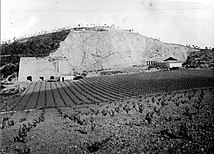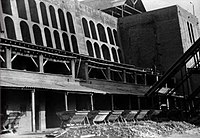Light railways of the cement factories near Castellet i la Gornal
| Light railways of the cement factories near Castellet i la Gornal | |
|---|---|
|
Decauville line of the Forns de Butsems
Fradera cement factory in Vallcarca Forns del Renet cement factory ( Ciments Miret ) in Santa Margarida i els Monjos, (en) around 1970 | |
| Gauge : | 600 mm ( narrow gauge ) |
The light railways of the cement factories near Castellet i la Gornal were narrow-gauge light railways with a gauge of 600 mm near Castellet i la Gornal (en) in the Comarca Alt Penedès in the province of Barcelona in the autonomous community of Catalonia ( Spain ).
history
Around 1890 was in Fornixa de Freixa Roman cement mined, a hardening in water building material with very short setting time . Around 1900 there were already three cement factories next to each other in the Castellet area, in whose ovens the cement was burned: Freixa, Renet (Miret) and Fradera. In order to bring the high-quality marl-limestone mixture from the quarries to the kilns and to transport coal and burnt cement, field railways and later aerial ropeways were used until truck transport prevailed.
business
The light rail carts were mostly moved by hand in the quarries. The routes were laid out in such a way that the loaded wagons rolled down to the factories by gravity. Horses or mules were mostly used to pull the empty carts back up to the quarry. On the descent, they could ride in a suitable horse-drawn carriage on the train. Since locomotives have not proven themselves on the steep routes, tractors were used instead of draft animals in the 1970s.
Web links
Individual evidence
- ^ A b Joan Rovira y Josep Maria Calaf: IV Trobada d Estudiosos del Foix Clariana (Castellet i la Gornal). June 16, 2016 ( Catalan ).
Coordinates: 41 ° 15 ′ 9.9 " N , 1 ° 35 ′ 56.9" E






